New Photos Reveal Giant Easter Island Moai Statues are
Covered in Mysterious Symbols
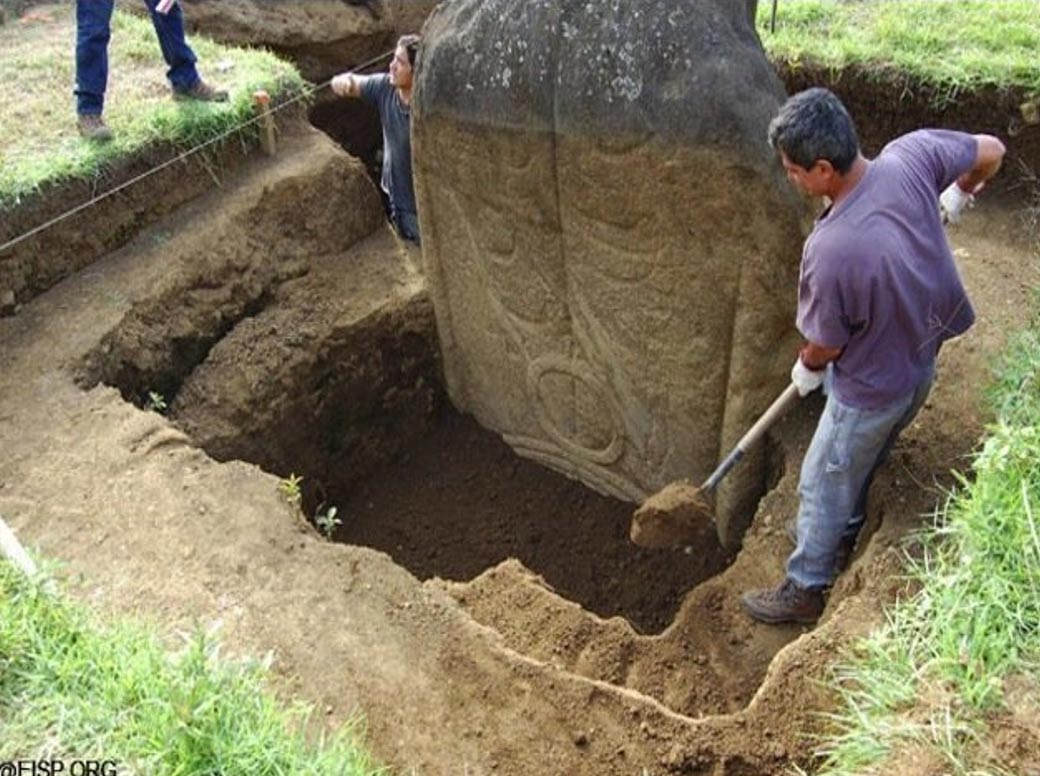
The intricately carved details as recorded in
2012. Archaeologists believe the decorations are tattoos. Credit: The Easter
Island Statue Project
By Liz Leafloor
New images from the 2012 excavation of Easter Island’s iconic statues reveal the renowned heads are not only connected to giant bodies, but the bodies are covered in mysterious designs and symbols, which researchers have likened to tattoos.
News.com.au reports that a previously unseen series of photographs show in fascinating detail the excavated bodies of the distinctive stone humanoids. Archaeologists were surprised to find that the stone bodies, shielded from environmental weathering beneath the soil, are decorated with ancient details — whirls and crescents believed to be tattoos.
Researchers say the crescent shapes might represent the canoes of local Polynesians, though this is just one theory.
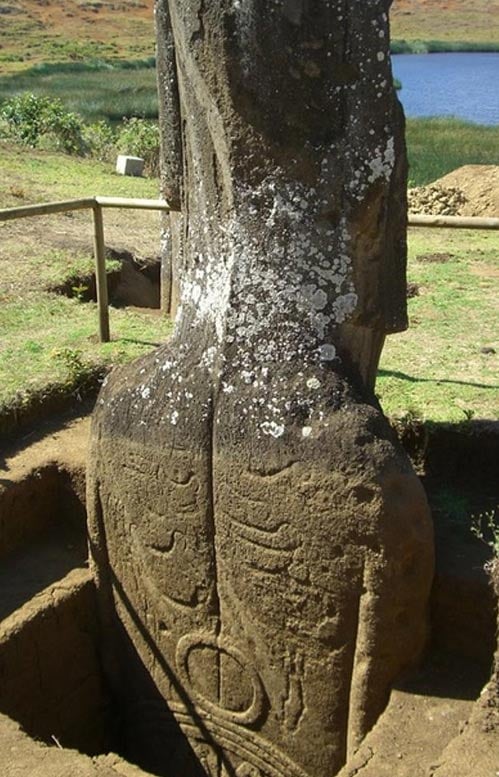
Detailed markings are visible. Credit: The
Easter Island Statue Project
The Rapa Nui people who originally settled the island centuries ago erected 887 amazing giant stone statues called moai. The moai have proved to be an enduring mystery with many lasting questions; how and why were they built; were they purposefully buried or did time bury the statues under silt; why do some face away from the sea and towards the island; how were the heavy stones moved around the island; why do some sport heavy red stone hats? Researchers hope to answer these questions and more with investigations.
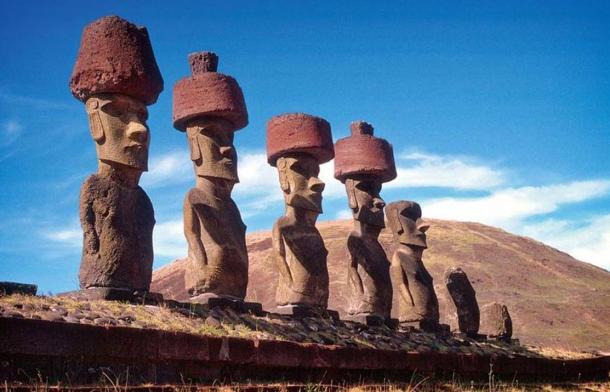
Moais (stone statues) on Ahu Nau, Anakena
Beach, Easter Island. Wikimedia Commons
Academics speculate the stylized figures represented ancestors or high status tribal figures. It is theorized that the stone was quarried on the island, and next it was carved and decorated at the quarries, and then finally the statues were “walked” slowly across the islands to their final positions as guardians protecting against disaster.
Explorer and author David Hatcher Childress wrote in a 2013 article:
"Jean-Michel Schwartz says in his 1975 book ‘The Mysteries of Easter Island’ that he believes the statues were not moved by wooden rollers or sleds but rather by using ropes around the statues which ‘walked’ the statues in the same way as one might walk a refrigerator; by tilting it first to one side, shifting the airborne portion forward, and setting it down again. By this method, the statues would truly walk in a waddle fashion around the island.
Later, a Czech mechanical engineer named Pavel recreated this method along with Thor Heyerdahl. With twenty other men, they tied ropes around a statue and leaned it from side to side while pulling it forward with the rope, a slight variation on Schwartz’s method. The method worked, but was excruciatingly slow. It is an ingenious theory which takes into account the legends of the walking statues […]"
Easter Island was settled between 300 AD and 1200 AD by Polynesians who eventually became the Rapa Nui. Between the 10th and 16th centuries the island community expanded steadily, with settlements being set up along practically the entire coastline. Following this period, however, the population took an extremely rapid decline dropping from 15,000 to approximately 2,000. Past theories explained their demise as the result of economic and social crises due to environmental deterioration: deforestation leading to land erosion. However, recent studies suggest the arrival of Europeans in the 1700s, and slavery and smallpox, are factors which probably devastated the population of the Rapa Nui.
Work continues on the island through university-led research, and the Easter Island Statue Project, along with assistance from the Rapa Nui people.
Galleries of images of Easter Island discoveries can be seen at the EISP.org site, and others are currently being viewed on social media site Imgur.
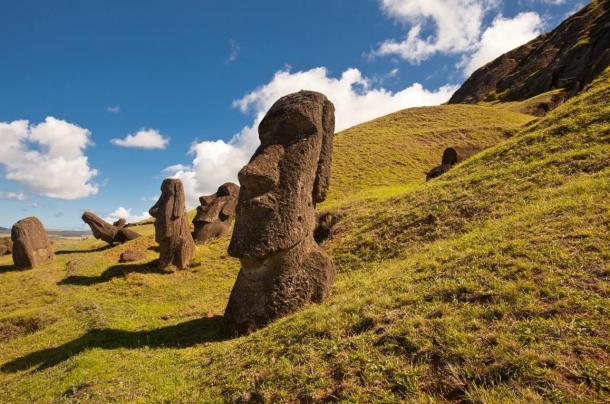
The famous moai of Easter Island
(BigStockPhoto)
The mysterious Rongorongo writing of Easter Island
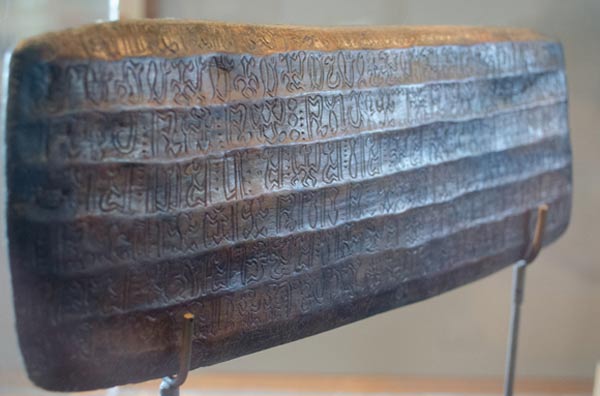
Rongorongo Tablet. Replica at the Englert
Museum. (Flickr)
By M R Reese
“In
every hut one finds wooden tablets or sticks covered in several sorts of
hieroglyphic characters: They are depictions of animals unknown on the island,
which the natives draw with sharp stones. Each figure has its own name; but the
scant attention they pay to these tablets leads me to think that these
characters, remnants of some primitive writing, are now for them a habitual
practice which they keep without seeking its meaning.”
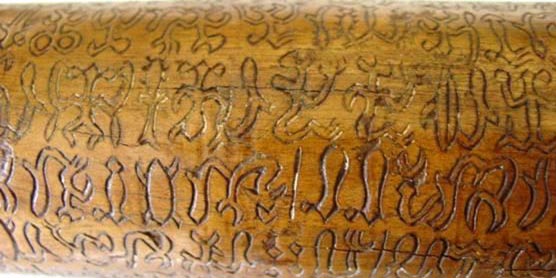
A mid-section of the Santiago Staff with
Rongorongo script. (Wikipedia)
The name Rongorongo comes from the Rapa Nui language, which is the native language of Easter Island, and means "to recite, to declaim, to chant out.” The irregularly shaped wooden tablets were weathered, burned, or otherwise damaged when they were found. The glyphs were also found on a chieftain's staff, a bird-man statuette, and two reimiro ornaments. The glyphs are written in-between lines that run across the tablets. Some tablets are “fluted” with the inscriptions falling within the channels created by the fluting. The Rongorongo images are shaped like humans, animals, plants, and geometric forms. Every symbol that contains a head is oriented with the head facing up, and either facing forward, or profiling to the right. Each symbol is approximately 1 centimeter high. The orientation of the writing is read from left to right, bottom to top. This is known as reverse boustrophedon. According to oral tradition, the tools used to make the carvings were obsidian flakes or small shark teeth.
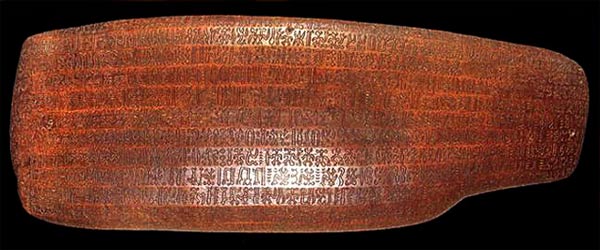
The Rongorongo characters were typically
written between lines that run across the tablet. (Wikipedia)
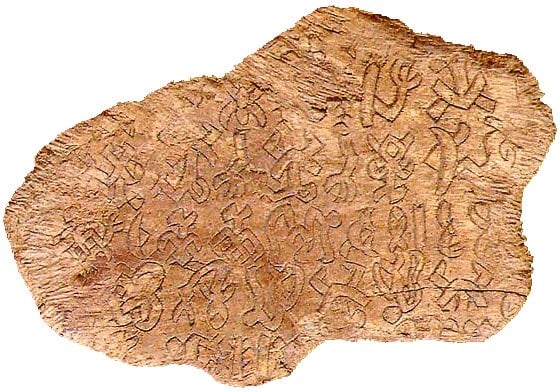
Side A of Rongorongo Tablet, the
Stephen-Chauvet fragment. (Wikipedia)
While it remains unclear exactly what the Rongorongo is intended to convey, the discovery and inspection of the tablets remain an important key to understanding the past civilizations of Easter Island. The intricately inscribed, neatly lined images indicate that the ancient island civilization had a message to convey, whether it was a casual display for decorative purposes, or to pass messages and stories forward from generation to generation. Perhaps deciphering the codes will someday lead to answers about the collapse of the island civilization, but for now, the tablets remain a mysterious symbol from the past.
Sources:
Rongorongo – Wikipedia. Available from: http://en.wikipedia.org/wiki/Rongorongo
Rongorongo – Omniglot. Available from: http://www.omniglot.com/writing/rongorongo.htm
10 of the World’s Biggest Unsolved Mysteries – Mother Nature Network. Available from: http://www.mnn.com/lifestyle/arts-culture/photos/10-of-the-worlds-biggest-unsolved-mysteries/rongorongo
Rongorongo – Princeton. Available from: https://www.princeton.edu/~achaney/tmve/wiki100k/docs/Rongorongo.html
From Ancient Origins @ http://www.ancient-origins.net/news-general/new-photos-reveal-giant-easter-island-moai-statues-are-covered-mysterious-symbols-020389
and http://www.ancient-origins.net/unexplained-phenomena/mysterious-rongorongo-writing-easter-island-002242
For more information about Easter Island see http://nexusilluminati.blogspot.com/search/label/easter%20island
- Scroll down
through ‘Older Posts’ at the end of each section
Hope you like this
not for profit site -
It takes hours of work every day by
a genuinely incapacitated invalid to maintain, write, edit, research,
illustrate and publish this website from a tiny cabin in a remote forest
Like what we do? Please give anything
you can -
Contribute any amount and receive at
least one New Illuminati eBook!
(You can use a card
securely if you don’t use Paypal)
Please click below -
Spare Bitcoin
change?
For further enlightening
information enter a word or phrase into the random synchronistic search box @
the top left of http://nexusilluminati.blogspot.com
And see
New Illuminati – http://nexusilluminati.blogspot.com
New Illuminati on Facebook - https://www.facebook.com/the.new.illuminati
New Illuminati Youtube Channel - http://www.youtube.com/user/newilluminati
New Illuminati on Google+ @ https://plus.google.com/115562482213600937809/posts
New Illuminati on Twitter @ www.twitter.com/new_illuminati
New Illuminations –Art(icles) by
R. Ayana @ http://newilluminations.blogspot.com
The Her(m)etic Hermit - http://hermetic.blog.com
DISGRUNTLED SITE ADMINS PLEASE NOTE –
We provide a live link to your original material on your site (and links
via social networking services) - which raises your ranking on search engines
and helps spread your info further!
This site is published under Creative Commons (Attribution) CopyRIGHT
(unless an individual article or other item is declared otherwise by the copyright
holder). Reproduction for non-profit use is permitted
& encouraged - if you give attribution to the work & author and include
all links in the original (along with this or a similar notice).
Feel free to make non-commercial hard (printed) or software copies or
mirror sites - you never know how long something will stay glued to the web –
but remember attribution!
If you like what you see, please send a donation (no amount is too
small or too large) or leave a comment – and thanks for reading this far…
Live long and prosper! Together we can create the best of all possible
worlds…
From the New Illuminati – http://nexusilluminati.blogspot.com
No comments:
Post a Comment
Add your perspective to the conscious collective